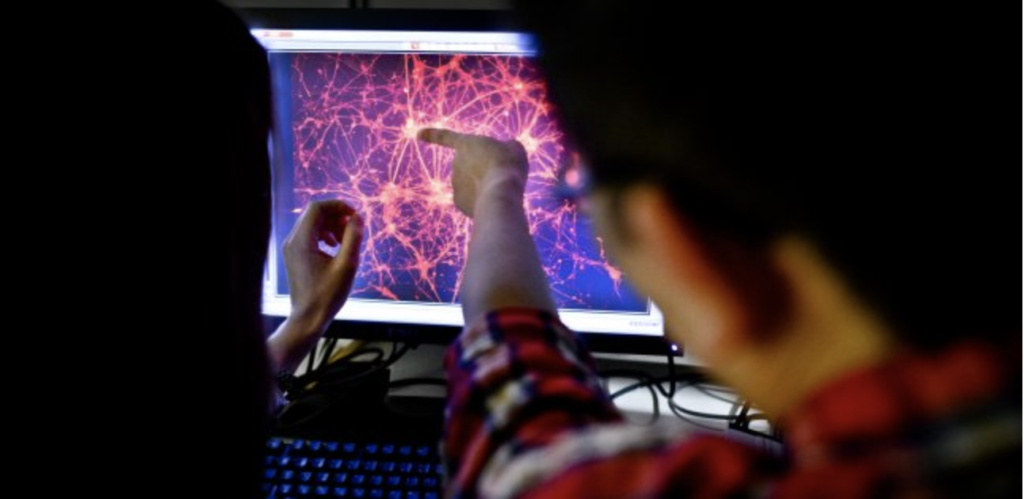#ScienceSaturday posts share relevant and exciting scientific news with the KAND community. This project is a collaboration between KIF1A.ORG’s Research Engagement Team Leader Alejandro Doval, President Kathryn Atchley and Science Communication Director Dr. Dominique Lessard. Send news suggestions to our team at impact@kif1a.org.
KIF1A.ORG Featured in “The Gene”
Part 1 of “The Gene,” a Ken Burns documentary featuring the KIF1A.ORG community, premiered on PBS Tuesday, April 7. This powerful film highlights our relentless drive and urgent mission to find a cure for this generation of patients affected by KIF1A Associated Neurological Disorder. If you missed the premiere, “The Gene” is available online for U.S. viewers.
Part One: Sneak Peek
Part Two
Join us virtually from the comfort of your own couch for the second part of of “The Gene,” airing on PBS April 14 8/7c in the U.S. From PBS:
“Part Two begins with the story of the signature scientific achievement of our time: the mapping of the human genome. As scientists learn to read the genetic code, they grapple with the dangers inherent in increasingly sophisticated and easily available methods of intervening in the very essence of what makes us human, our DNA.”
Recent KIF1A-Related Research
Concerted action of kinesin-1 KIF5B and kinesin-3 KIF13B promotes efficient transport of exocytotic vesicles to microtubule plus ends
This pre-print article focuses on the role of KIF13B and KIF5B in cargo transport along microtubule roadways. Specifically, this study explores how KIF13B and KIF5B work together like a team, attached to the same cargo, to facilitate transport along obstacle-coated microtubules. KIF13B is a kinesin-3 family member, like KIF1A. As KIF proteins are grouped into kinesin families based on shared characteristics, we can learn a lot about KIF1A by studying other kinesin-3 family members.
UNC-10/SYD-2 complex is sufficient to link kinesin-3 to RAB-3 containing synaptic vesicles in the absence of the motor’s PH domain
Another pre-print article released this week investigates the attachment between UNC-104 (the name for KIF1A in the C. elegans model organism) and a cargo known as RAB-3 containing synaptic vesicles. This study reveals that, in order for UNC-104 (KIF1A) to attach to this cargo, other proteins help tether the two together. From this we learn new information about the proteins involved in UNC-104/KIF1A cargo transport, and how changes in this relationship may alter KIF1A function.
Bonus: What’s a Preprint?
From bioRxiv:
“Before formal publication in a scholarly journal, scientific and medical articles are traditionally ‘peer reviewed.’ In this process, the journal’s editors take advice from various experts—called ‘referees’ … Because this process can be lengthy, authors use the bioRxiv service to make their manuscripts available as ‘preprints’ before completing peer review and consequent certification by a journal. This allows other scientists to see, discuss, and comment on the findings immediately.”
While preprints are not final, peer-reviewed publications, they do enable the scientific community and stakeholders like us to have more immediate, open access to the latest advancements in scientific discovery.
Rare Disease News
A repairable brain: cell reprogramming to halt neurodegenerative disease
Neuronal cell death is a pathological characteristic of many neurodegenerative diseases, leading to detrimental symptoms in affected patients. In attempts to combat the effects of neuronal cell death, researchers at Lund University in Sweden have begun reprogramming non-neuronal cell types in the nervous system into neurons. The “IN-BRAIN” project is primarily centered around improving the treatment and daily life of Parkinson’s, Huntington’s, and Alzheimer’s disease patients, but has broad implications for other neurodegenerative diseases with neuronal cell death. While ongoing research is being conducted in clinically relevant model systems, the ultimate goal would be to create novel therapies for patients. Click the image below to read more!
“This is really transformative in the field of brain repair. If we learn to create new neurons in a controlled way in the brain, it opens up possibilities to replace neurons lost to disease and to repair brain circuitry.”



[…] last week’s Science Saturday, we discussed the idea of repairing a neurodegenerative brain by reprogramming non-neural cell […]